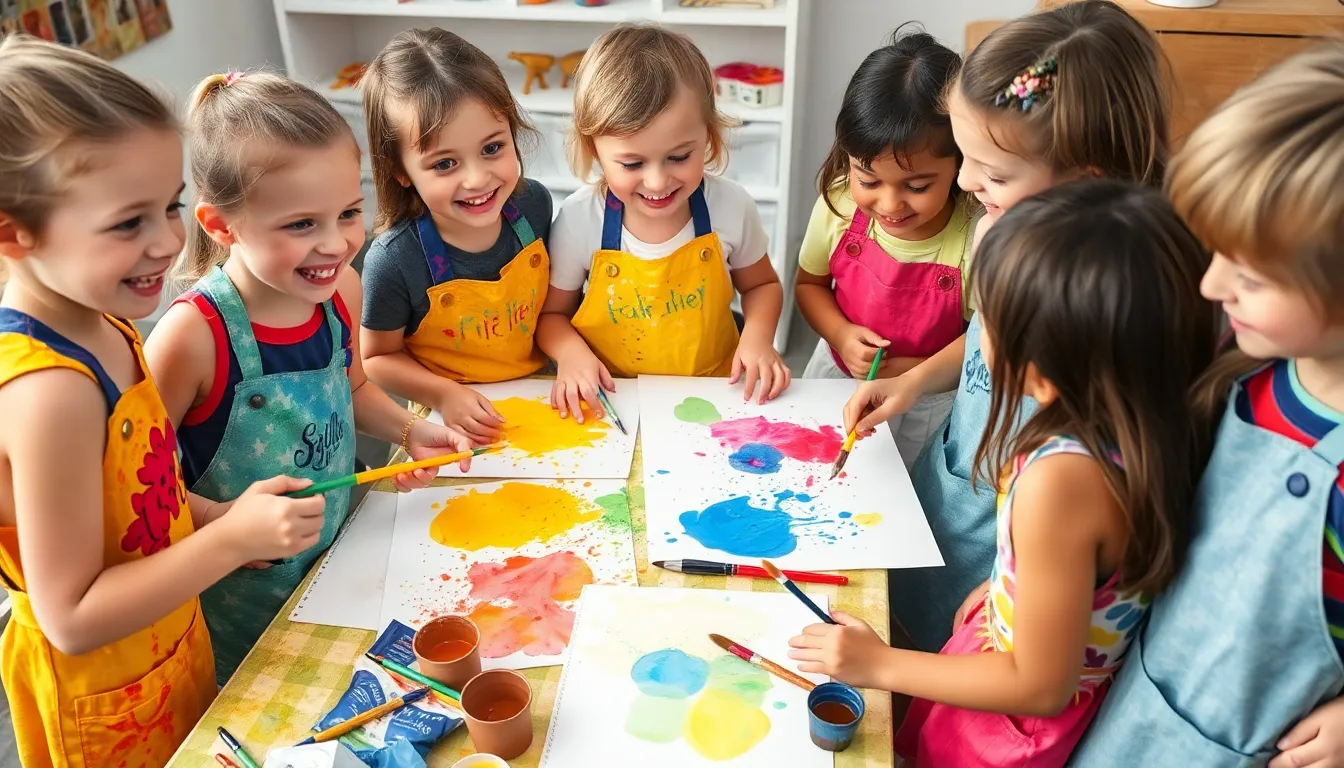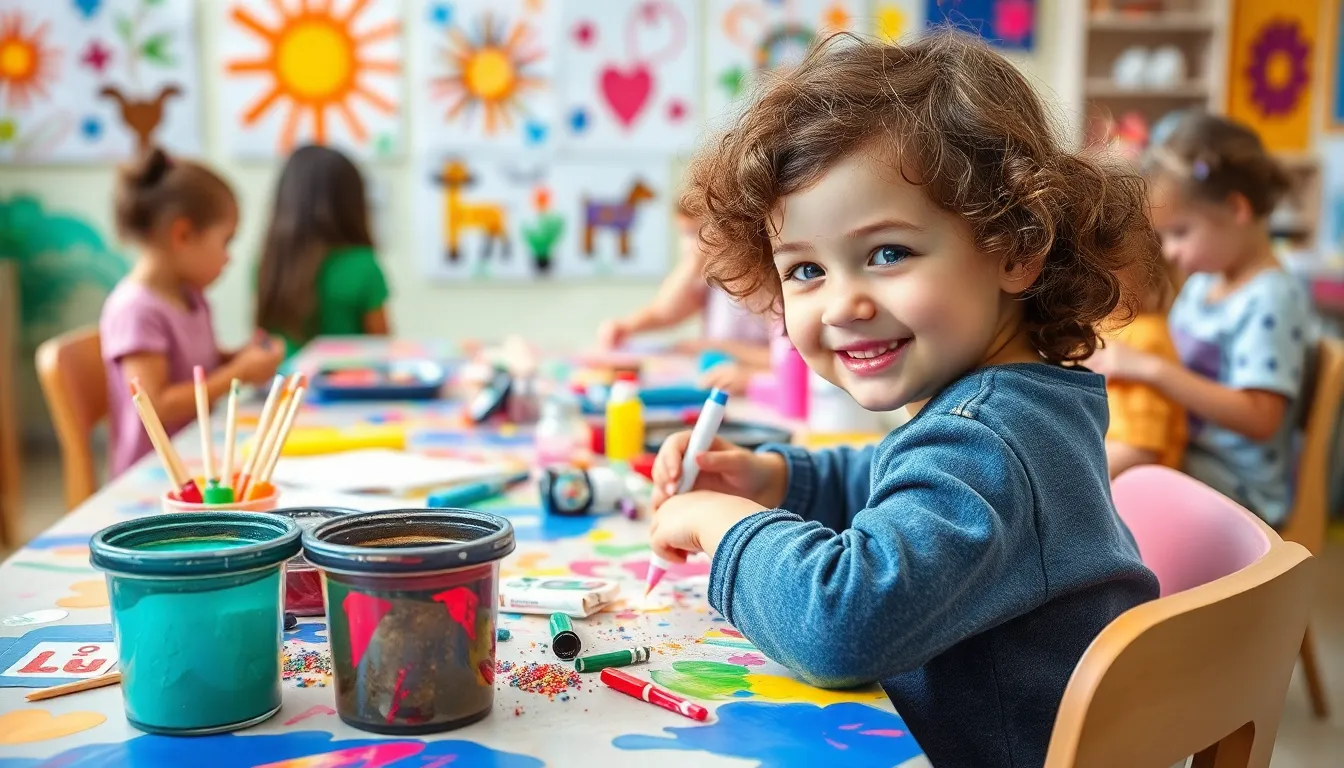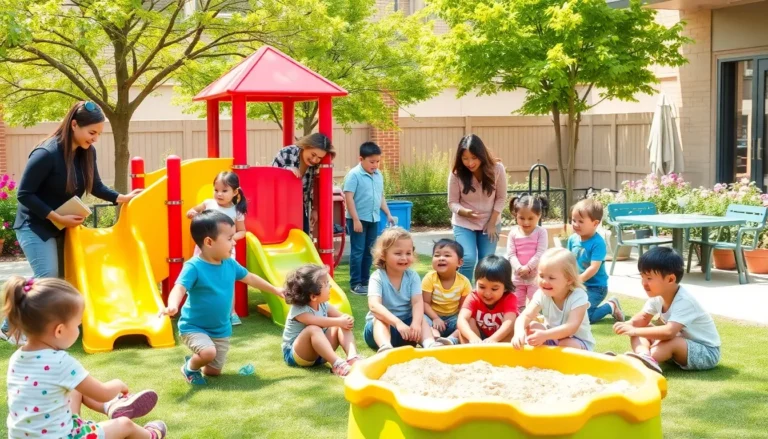Preschool arts and crafts are the secret sauce to sparking creativity in young minds. Picture this: tiny hands covered in paint, glitter flying through the air, and the unmistakable sound of giggles as kids transform everyday materials into masterpieces. It’s not just fun; it’s a magical journey that nurtures imagination and fine motor skills all at once.
Table of Contents
ToggleOverview of Preschool Arts and Crafts
Preschool arts and crafts play a crucial role in child development. Engaging in these activities nurtures creativity and imagination while enhancing fine motor skills.
Importance of Arts and Crafts in Early Childhood
Arts and crafts significantly contribute to a child’s growth. They encourage self-expression, allowing kids to communicate emotions and ideas visually. Engaging in various projects fosters problem-solving skills, promoting independence and confidence. Additionally, these activities introduce concepts like colors, shapes, and textures, enriching cognitive development. Participation in group projects cultivates collaboration, teaching children to work as a team. Overall, arts and crafts create a foundation for learning and social interaction.
Creative Development Through Arts and Crafts
Creative development flourishes through arts and crafts activities. While using different materials, children explore their artistic abilities, experimenting with techniques and methods. Crafting helps them discover their preferences and develop unique styles. Exposure to art forms fosters an appreciation for creativity in all its forms. Through hands-on experiences, kids learn to think critically and innovate, skills valuable for future learning. These activities fuel imaginative play, allowing children to express themselves freely and boldly.
Types of Preschool Arts and Crafts

Preschool arts and crafts encompass various activities that nurture creativity and facilitate skill development. These activities range from painting to seasonal projects, each enhancing children’s artistic abilities in unique ways.
Painting and Drawing Activities
Painting and drawing activities foster imagination and allow children to explore colors and shapes. Children can experiment with watercolor, acrylic, and finger paints. Simple drawing tasks, like creating outlines of their favorite animals, help develop coordination and artistic skills. Utilizing different brushes and tools encourages them to discover various textures. Each drawing session provides an opportunity for children to express their emotions and thoughts visually. This type of art also introduces basic concepts in color theory and spatial awareness.
Collage and Mixed Media Projects
Collage and mixed media projects combine various materials, allowing children to explore creativity without limits. Kids can use paper, fabric, and natural elements, such as leaves or flowers, to create vibrant compositions. Engaging in these projects promotes fine motor skills and hand-eye coordination. They learn to cut, glue, and arrange materials, enhancing cognitive and problem-solving skills. Exposure to diverse textures and patterns in these activities broadens their artistic understanding. Every project serves as a unique representation of their personal interests and experiences.
Seasonal and Holiday Crafts
Seasonal and holiday crafts celebrate various occasions while providing artistic experiences. Children can create decorations for holidays like Halloween, Christmas, or Thanksgiving. Common activities include making paper snowflakes, handprint turkeys, or festive ornaments. Engaging in such crafts helps build a connection with cultural traditions and seasonal themes. Kids often learn to follow instructions while expressing their creativity through color and design. Each completed project becomes a cherished keepsake, enriching their understanding of celebration and community.
Benefits of Engaging in Arts and Crafts
Arts and crafts offer numerous benefits for preschool children. Engaging in hands-on creative activities supports their overall development in various ways.
Enhancing Fine Motor Skills
Fine motor skills improve significantly through successful arts and crafts projects. Children strengthen hand-eye coordination while wielding scissors, painting brushes, and glue sticks. Using these tools helps develop precise movements necessary for tasks like writing. Additionally, manipulating small objects, such as beads or paper pieces, enhances grip strength. Parents and educators often notice increased dexterity in children engaged in these activities. Regular practice leads to greater control and encourages independence as they master new skills.
Boosting Cognitive Development
Cognitive development experiences notable enhancement as children engage in arts and crafts. Exploring colors, shapes, and textures stimulates curiosity and critical thinking. Creative projects often challenge young minds to problem-solve while making decisions. Discussing their art helps develop language skills and emotional awareness. Collaboration during group projects promotes social interaction and cooperative learning. Children can connect their feelings and thoughts visually while discovering new concepts. Participation in various crafts enriches their understanding of the world around them, setting the stage for lifelong learning.
Recommended Materials for Preschool Arts and Crafts
When selecting materials for preschool arts and crafts, prioritize safety and creativity. Choosing the right supplies makes projects enjoyable and accessible.
Safe and Non-Toxic Supplies
Using safe and non-toxic supplies ensures children’s health and well-being. Child-safe paints labeled non-toxic promote creativity while keeping little hands safe. Crayons and markers specifically designed for young children provide vibrant colors without harmful chemicals. Paper options such as recycled or acid-free kinds allow for eco-friendly crafting experiences. Adhesives should be washable and child-friendly to avoid messes and harmful ingredient exposure. Selecting these materials encourages both fun and peace of mind during art sessions.
Budget-Friendly Craft Options
Budget-friendly craft options make arts and crafts accessible for everyone. Items like construction paper, yarn, and scissors can be found at low costs yet remain engaging for children. Reused materials, such as cardboard boxes or magazines, inspire creativity while teaching resourcefulness. Natural materials, like leaves and stones, offer unique textures and colors without breaking the bank. By prioritizing affordability, parents and educators can spark creativity in children without significant financial investment.
Tips for Successful Arts and Crafts Sessions
Creating a positive atmosphere during arts and crafts sessions enhances children’s creativity and enjoyment. An inviting and stimulating environment encourages exploration and expression.
Creating an Inspiring Environment
Arrange a dedicated craft space filled with vibrant colors and accessible supplies. Display finished art pieces to spark imagination and inspire young artists. Providing a variety of materials, such as recycled items and natural elements, fosters creativity through diverse textures and forms. Soft music in the background may also boost focus and engagement. Ensuring good lighting aids in visibility, making it easier for children to see details while they create. Comfortable seating supports prolonged activities, allowing kids to fully immerse themselves in their projects.
Encouraging Free Expression
Allow children the freedom to create without strict guidelines. Offering open-ended projects encourages innovation as kids explore their ideas. Providing choices in colors, materials, and techniques empowers young artists to express their feelings and perspectives. By asking open questions about their artwork, adults can stimulate thoughtful conversations that enhance language skills and emotional awareness. Recognizing and praising individual expression builds confidence and motivates further creativity. Engage kids in discussions about their process, making them feel valued and heard in their artistic journeys.
Preschool arts and crafts play a vital role in nurturing creativity and development in young children. These activities not only provide a platform for self-expression but also enhance fine motor skills and cognitive growth. By engaging in various projects children learn to collaborate and communicate effectively while exploring their imaginations.
Emphasizing safe and budget-friendly materials ensures that every child can participate in these enriching experiences. Creating a positive and inspiring craft environment further encourages children’s creativity and confidence. Ultimately, preschool arts and crafts lay a strong foundation for lifelong learning and social skills, making them an essential part of early childhood education.




